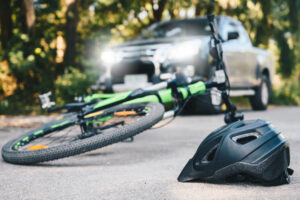Cycling and the Colorado lifestyle go hand-in-hand. Whether you are using your bike to get ahead of the morning rush hour around Lo-Do or taking your mountain bike into the high country, cycling is a great form of transportation and exercise. In fact, thousands of people bike in Colorado on a daily basis. The fear of facing a bicycle accident is not always the first thing on their minds as they pedal down the street or trail. They plan to hop on the bike, do what they set out to do, de-stress, and return home.
Nevertheless, countless bicycle accidents and fatalities occur yearly because of negligent motorists. In the event that you or someone you love has suffered injuries in a bicycle crash involving a motorist, you should contact a bicycle accident lawyer as soon as you can.
Bicyclists Are Vehicles
First things first: it’s crucial to recognize that a bicycle is a vehicle. Bicyclists and motorists have the same responsibilities as each other while on the road. They have rights and regulations to adhere to, just like cars and trucks. Both bicyclists and motorists need to know this is in place to ensure the roadways are safer for everyone.
Because of accidents caused by cars, preventable bicycle deaths have increased by 44 percent in 10 years and by 16 percent in a recent year alone. There were 932 deaths and 325,173 injuries from bicycle accidents involving motorists. Their deaths account for 2 percent of all motor vehicle traffic fatalities.
Drivers should look out for bicyclists and make prudent decisions to keep Colorado’s roads safe for everyone. Ultimately, they have the same rules, so they should be treated the same as vehicles—which means giving them the right of way when appropriate and plenty of space to maneuver.
Traffic Laws Apply to Everyone
There should not be a need to say this in the first place, but drivers have to obey all traffic laws, signs, and signals. This requirement doesn’t just refer to stop signs and speed limits; motorists must adhere to every single road sign they encounter to avoid preventable bicyclist injuries and deaths.
It can all be a chain reaction: a motorist might be far from a bicyclist, but if they run a stop sign, they can hit the cyclist coming from a distance. If they’re following the speed limit signs, they might need more time to slow down when bicyclists appear in view.
Sometimes, as new motorists, we take extra care to follow every sign we come across because it is such a new experience. Yet, time and more experience may bring about feelings of overconfidence, resulting in only sometimes following every signal.
Leave Some Space
In Colorado, motorists must leave at least three feet of space between themselves and a bicyclist when trying to pass them. Estimating these three feet is essential based on the vehicle’s widest and the bicycle’s widest points. This distance should include all mirrors and other projections outside the car. It does not matter if the bicyclist is in a bike lane or on a dirt trail; the motorist must always maintain this distance.
While this rule is certainly a good start, many bicycle advocates claim that three feet are insufficient, especially when a large commercial truck is trying to pass them. When placed in actual road conditions, with possible debris around, bad weather, and road irregularities like potholes, they say it may be difficult to gauge how to adjust their course. Some states require four feet, but it’s just three in Colorado.
When to Pass a Bicyclist?
Sometimes, motorists understandably need to pass a bicyclist traveling at an average speed of 10 to 15 miles per hour. Drivers need to get places on time, and it’s only natural to want to drive at the posted speed limit.
Nevertheless, they must follow the rules when trying to pass a bicyclist. When there is a double-yellow centerline, they can safely cross it only when the road ahead is clear, and there are no oncoming vehicles. If a vehicle is coming down the other lane, even if it might appear very far, motorists must wait until they have passed to pass the bicyclist.
In general, drivers should only pass a bicyclist if they allow an oncoming vehicle at least half of the mainly-traveled part of the roadway. Imagine a road lane and break that in half. The motorist must provide that half to pass the bicyclist. In other words, unless they have enough space within their lane to safely give the bicyclist and the oncoming vehicle sufficient distance to cross, they are to stay behind the bicyclist until they can pass them.
Do Not Obstruct Bike Lanes
Motorists are not to obstruct bicycle lanes in any way. Drivers are to refrain from parking their vehicles over the bicycle lane at any time. They cannot continuously drive over them; they can only maneuver across a bike lane when they need to make a left or right turn after first checking for any oncoming bicyclists.
Sometimes motorists are waiting for someone or picking something up from a building or restaurant, but they must follow all rules, even if it is just for a moment. They cannot idle in any bicycle lanes, even for the slightest amount of time. They must also be cautious when opening their car doors. Dooring accidents happen more often than one might think and are capable of causing extremely severe injuries – especially if the bicyclist was moving quickly and did not see the car door in time to try to slow down.
Don’t Drive Without Looking for Bicyclists
 Drivers have a duty to be aware of their surroundings. This is another rule that should be a part of every motorist’s common sense and should not have to be said, but many drivers need to hear it. Bicycles are clearly much smaller and harder to spot than cars and trucks, but they are vehicles just the same. As a result, drivers have a legal duty to be on the lookout for cyclists, and failing to do so is negligence. There are already a lot of distractions being thrown at motorists as they’re driving, like heavy traffic and aggressive drivers, but there is no excuse not to look out for bicyclists.
Drivers have a duty to be aware of their surroundings. This is another rule that should be a part of every motorist’s common sense and should not have to be said, but many drivers need to hear it. Bicycles are clearly much smaller and harder to spot than cars and trucks, but they are vehicles just the same. As a result, drivers have a legal duty to be on the lookout for cyclists, and failing to do so is negligence. There are already a lot of distractions being thrown at motorists as they’re driving, like heavy traffic and aggressive drivers, but there is no excuse not to look out for bicyclists.
Respect the Bike Lanes
Motorists always need to respect bicycle lanes. Aside from what was mentioned above regarding not parking or idling over them, drivers must be aware that bicyclists have the right-of-way on these lanes. This mandate applies even when the bike lane goes through an intersection.
If a motorist does not provide the bicyclist with the right-of-way, it can be considered a Class A traffic infraction under Colorado law. If the driver’s actions here lead to a crash, the careless driver will be punished and subjected to a Class 2 misdemeanor traffic offense. If the accident leads to bodily harm to the bicyclist or even death, it is considered a class 1 misdemeanor traffic offense.
Treat Bicyclists as Vulnerable
Compared to people in vehicles, cyclists are extraordinarily vulnerable on the road, and drivers should treat them as such. They lack the protection that cars have and are constantly exposed to the elements around them. Because of this, they are more likely to get into accidents that lead to critical injuries or even death. Traditional road design does not benefit bicyclists; they are for cars and trucks. Depending on other factors such as speed and road conditions, the slightest touch from a car can cause the bicyclist to lose balance and fall off.
Bicycle helmets are crucial to bicyclists and can reduce traumatic brain injuries, facial injuries, and fatalities. In a study of many bicycle accidents, 13 percent wore helmets and still received severe injuries, and 3 percent died. It shows that even when bicyclists are protecting themselves and following the law by wearing a helmet, they are still more susceptible to harm on the road.
Don’t Drive Distracted
Distractions on the road are an ever-growing problem for motorists and bicyclists. Distracted driving is one of the leading causes of motor vehicle accidents overall. It is the reason for over 3,000 deaths and more than one million accidents annually. It poses an even greater danger to bicyclists since they lack the protection of a vehicle body around them.
Distracted driving can come in many forms, such as:
- Using the cellphone
- Eating or drinking
- Using GPS devices
- Being stressed
- Not getting enough sleep leads to a tired and sleepy driver
- Looking at the surroundings
- Messing with the radio
- Reaching over to hand something to a passenger in the back
- Daydreaming or becoming lost in thought
Surprisingly, eating or drinking is thought to be up to 80 percent riskier than cellphone use while driving. If the food or drink spills, it requires immediate attention, and the driver’s first instinct is to try and pick up everything or prevent it from spilling more. Doing so leads them to take their eyes off the road and hands off the steering wheel, potentially causing them to lose control and hit bicyclists.
Whether the distractions are cognitive, visual, or manual, they pose a danger to bicyclists just trying to exercise or get to where they need to be. More than 90 percent of Colorado drivers self-report driving distracted, so the state is cracking down on those that do not pay full attention to the road.
Projecting Things at Bicyclists
In Colorado, if a motorist knowingly projects a missile against another vehicle or equipment designed for transportation, it is considered a class 2 petty offense. A conviction is punishable by up to six months in jail and $500 in fines. However, when it comes to projecting an object against a bicyclist, it turns into a class 2 misdemeanor. It is punishable by up to 120 days in jail and $750 in fines. In the context of this law, a missile means any object or substance.
Utilize the “Dutch Reach”
While not the law, many safety advocates encourage drivers to utilize the Dutch Reach when opening their doors. It’s a safety technique designed to stop bicyclists from being hit by car doors as they pass parked cars. The name comes from the fact that this is standard practice in many parts of Europe, including the Netherlands, which has more bikes per capita than anywhere else in the world.
The Dutch Reach requires the motorist to open the door with their hand closest to the center of the car. Doing so forces the motorist to look back over their shoulder and down the road for bicyclists. In the U.S., if the driver is the one opening the door, they will open it with their right hand, propelling their body in a manner that obligates them to look back.
Protecting Your Rights After a Bicycle Accident
While these and other laws exist to protect cyclists, accidents will continue to occur. If you are hurt by the negligence of a motorist or someone else while you are on a bike, there are certain steps you should take to protect your legal rights under Colorado law. These include:
See a Physician
You should always seek medical attention after a bicycle accident, even if emergency medical personnel have cleared you to go home. Seeing a doctor will ensure your injuries are identified and documented.
Do Not Sign Any Paperwork Regarding Your Accident
You may receive a settlement offer shortly after your bicycle accident. This initial offer is very likely to be far less than your case is worth. Never sign anything related to your legal rights after an accident without talking to a lawyer first.
Retain a Lawyer as Soon as You Can
Finally, you should contact a lawyer as soon as possible after a bike accident. Once you have a lawyer, they will handle all of the legal aspects of your claim and make sure your rights are protected.
Call a Bicycle Accident Attorney Today
Were you injured in a Colorado bicycle accident? Call an experienced bicycle accident attorney to discuss your case and fight for compensation.




















